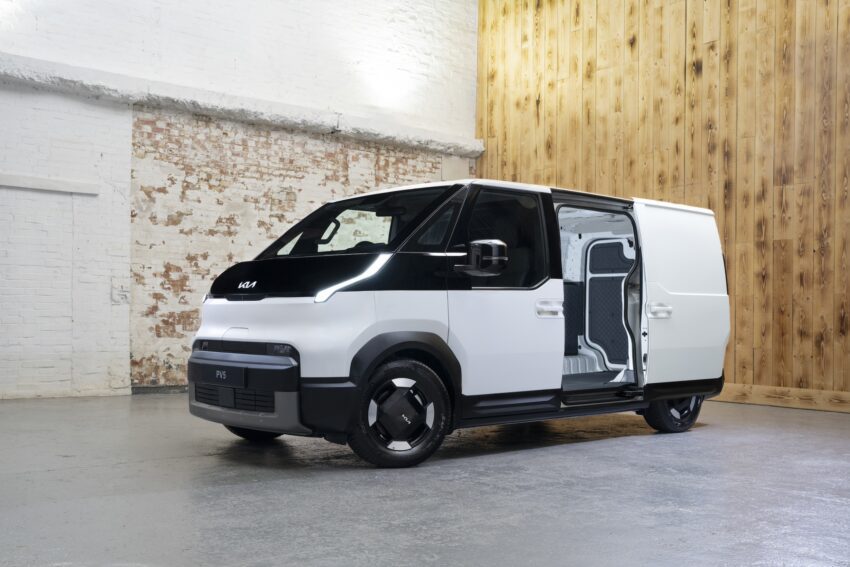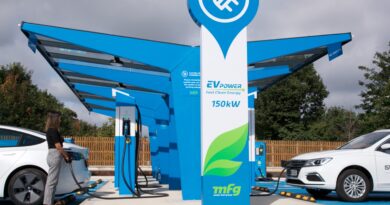
Kia PV5 gets range boost before it even hits the road
Kia has announced improved range for its PV5 Cargo and Passenger vans ahead of their launch later this year.
Both Standard and Long Range variants of the two vehicles have received minor updates to their WLTP figures as part of ongoing testing, boosting them by between three and 11 miles.
The PV5 Cargo now offers 184 miles of range in Standard Range form, up from 181, while the Long Range model jumps from 247 to 258 miles.
In the seven-seat Passenger version, the Standard Range has improved from 179 miles to 183 while the Long Range variant will now cover up to 256 miles, up from 249.
The PV5 is Kia’s first attempt at a commercial vehicle, and the all-new all-electric van will initially be available as the PV5 Cargo and PV5 Passenger variants, with crew cab, chassis cab and wheelchair accessible version joining the line-up at a later date.
Pricing for the Kia PV5 Cargo model will start at £27,645 before VAT. However, the van will also be eligible for the full plug-in van grant, which offers a £5,000 reduction.
The PV5 passenger will be priced from £32,995 and orders for it and the Cargo will open on May 1, with first deliveries scheduled for late 2025. Prices for other variants will be confirmed later in the year.
At launch, the PV5 Cargo and Crew will only be available in L2/H1 format, with L1/H1 and L2/H2 versions of the Cargo going on sale in 2026. All versions of the Kia PV5 Passenger will be based on the L2/H1 variant. Five-seat versions offering up to 1,320 litres of space behind the rear seats will be joined by a seven-seat version in 2026.

Across commercial and passenger versions, the PV5 will be offered with a choice of two powertrains. Entry-grade vans will use a 51.5kWh battery mated to a 120bhp motor driving the front wheels. As per the latest testing, in the Cargo L2/H1 this will give a maximum range of 184 miles and allow for a maximum payload of 790kg. A long-range 71.2kWh battery – priced from £30,145 +VAT – reduces the payload to 690kg due to its extra weight, but boosts the PV5 Cargo’s range to 258 miles and gets a 161bhp motor. All L2/H1 versions offer 4.4m3 of cargo space.
Range, payload and cargo space put the launch version of the PV5 somewhere between models like the Ford E-Transit Custom and the more compact E-Transit Courier, with pricing directly competing with the smaller Ford model.
In the PV5 Passenger, the two batteries now offer ranges of 183 miles and 249 miles respectively. DC charging rates for the two batteries have not been specified but Kia says both will charge from 10-80% in less than 30 minutes on a 150kW charger.
PV5 Cargo and Passenger versions will be sold in two simple trim levels – Essential and Plus.
All models get 16-inch steel wheels, LED lights, front and rear parking sensors with reversing camera, a 12.9-inch touchscreen with wireless phone mirroring, 7.5-inch digital instruments and automatic air conditioning. Cargo versions get one sliding side door while Passenger variants get two.
On all versions, Plus spec adds heated front seats and steering wheel, wireless phone charging, power folding mirrors, vehicle-to-load and vehicle-to-X capabilities, rear cross traffic alert, blind spot collision avoidance and safe exit warning. In addition, passenger versions get a powered tailgate, electrically adjustable front seats and 16-inch alloy wheels.

In Cargo guise, both trims will come with the option of either powertrain while the PV5 Passenger Plus will only get the larger battery and more powerful motor. Pricing for that version is still to be confirmed.
On sale later this year, the five-seat PV5 Crew will only be available in L2/H1 form and with the 51.5kWh battery offering up to 174 miles range. Payload is rated at 605kg, and the cargo area offers 2.4-3.7m3 of space, depending on the position of the rear bench, which incorporates the bulkhead.
The Chassis Cab, meanwhile, will only come in L2 configuration but with the option of both battery packs. Range will be 155 miles or 217 miles, and payload is rated at 995kg for the long range battery option.





